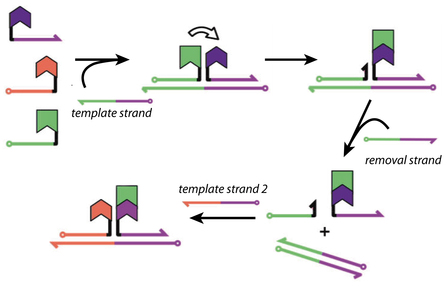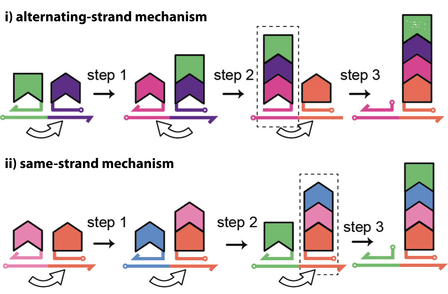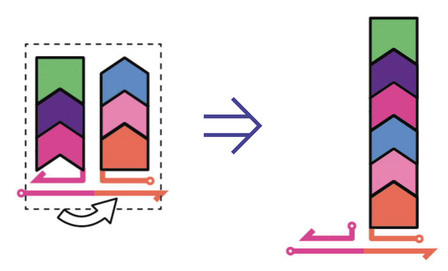Reference: J. Am. Chem. Soc., 2012, 134 (3),1446–1449
Title: Programmable One-Pot Multistep Organic Synthesis Using DNA Junctions
Authors: M.L. McKee, P.J. Milnes, J.Bath, E. Stulz, R.K. O’Reilly, and A. J. Turberfield
Review by: Sergii Rudiuk
Title: Programmable One-Pot Multistep Organic Synthesis Using DNA Junctions
Authors: M.L. McKee, P.J. Milnes, J.Bath, E. Stulz, R.K. O’Reilly, and A. J. Turberfield
Review by: Sergii Rudiuk
The authors show the application of DNA hybridization for the control of the regioselectivity of multistep organic synthesis.
For this purpose, specific single strand oligonucleotides were attached to reactive monomers having two functional groups (aldehyde and ylide) allowing them to be coupled by the Wittig reaction. Different monomers have been then mixed at low concentrations (1nM), disabling their interconnection in absence of template. The authors succeed to control the order of one-pot interconnections between the monomers by subsequent addition of corresponding template strands and removal strands. In fact, the addition of template DNA strands leads to their hybridization with 2 specific monomer’s strands and to local increase of their efficient molarity, and thus the reaction rate. After the reaction step, the removal strand, complementary to the template strand, is added and the reaction product is released from the template DNA. Authors succeed to repeat this procedure 3 times and to obtain tetramers of programmed structure with 17% total yield.
For this purpose, specific single strand oligonucleotides were attached to reactive monomers having two functional groups (aldehyde and ylide) allowing them to be coupled by the Wittig reaction. Different monomers have been then mixed at low concentrations (1nM), disabling their interconnection in absence of template. The authors succeed to control the order of one-pot interconnections between the monomers by subsequent addition of corresponding template strands and removal strands. In fact, the addition of template DNA strands leads to their hybridization with 2 specific monomer’s strands and to local increase of their efficient molarity, and thus the reaction rate. After the reaction step, the removal strand, complementary to the template strand, is added and the reaction product is released from the template DNA. Authors succeed to repeat this procedure 3 times and to obtain tetramers of programmed structure with 17% total yield.

Dependently on the chemical structure of the monomers, two distinct mechanisms have been achieved:
i) alternating-strand mechanism when the growing chain is transferred between adapters at each step (as in the ribosome)
ii) same-strand mechanism when the growing chain is assembled on a single adapter.
i) alternating-strand mechanism when the growing chain is transferred between adapters at each step (as in the ribosome)
ii) same-strand mechanism when the growing chain is assembled on a single adapter.

Authors show that the combining of the both mechanisms halves the number of operations required to make a product of a given length, allowing access to more complex product libraries. For example, by synthesizing sections in parallel, the authors succeed to decrease the number of reaction steps required to make an oligomer of a given length: a 6-mer was synthesized in three reaction steps.

The advantages of this system over others are: i) it doesn’t require sequential addition of reactants, and ii) this method permits programmable parallel synthesis of multiple products.